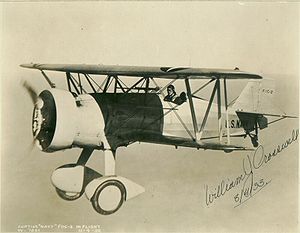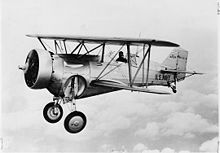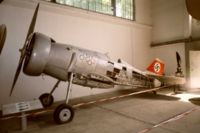Curtiss F11C Goshawk Video - Picture

|
|
Curtiss F11C Goshawk
F11C Goshawk

Picture - XF11C-2 Goshawk, piloted by Curtiss test pilot William J. Cresswell, pictured during a test flight, 4 August 1933.
Role: Carrierborne Fighter & Fighter-Bomber
Manufacturer: Curtiss Aeroplane and Motor Company
First flight: September 1932
Introduced: April 1932
Primary user: United States Navy
Produced: October 1932
Number built: 28 plus 2 prototypes
For other uses of Goshawk, see Goshawk (disambiguation)
The Curtiss F11C Goshawk was a 1930s United States naval biplane fighter aircraft that saw limited success but was part of a long line of Curtiss Hawk airplanes built by the Curtiss Aeroplane and Motor Company for the American military.
Design and development
In April 1932, when Curtiss was planning the Model 35B, the United States Navy contracted with the manufacturer for an improved derivative of the Model 34C, F6C as the F11C. It contained major changes that included the 600 hp (447 kVV) Wright R-1510-98 radial engine, single-leg cantilever main landing-gear units, a slight increase in the interplane gap, metal- rather than fabric-covered control surfaces, and armament based on two 0.3 in (7.62 mm) fixed forward-firing machine guns supplemented by a hardpoint under the fuselage for the carriage of a 474 lb (215 kg) bomb, or an auxiliary fuel tank. Curtiss designed the type as the Model 64 Goshawk, with the US Navy designation XF11C-1 (later XBFC-1 after the adoption of the BF for Bomber-Fighter category). The aircraft was of fabric-covered metal construction, used the wing cell structure of the dismantled YP-23, and was delivered in September 1932.
Shortly before ordering the XF11C-1, the Navy had bought a company-owned Model 64A demonstrator. This had a Wright R-1820-78 Cyclone engine, slightly longer main landing-gear legs carrying wheels with low-pressure tires, a tailwheel in place of the tailskid, fabric-covered control surfaces on the tail, and external provision for underwing racks for light bombs as well as an under-fuselage hardpoint for either a 50 gal (189 l) fuel tank or the crutch that would swing a bomb clear of the propeller disc before release in a dive-bombing attack.
Flight trials of this XF11C-2 (later redesignated as the XBFC-2) revealed the need for a small number of minor changes. After making the changes, the XF11C-2 came to be regarded as the prototype for the F11C-2, of which 28 examples were ordered as dual-role fighter-bombers in October 1932.
From March 1934 the aircraft were revised with a semi-enclosed cockpit and a number of other modifications before they received the revised designation BFC-2 in recognition of their fighter-bomber or, as the Navy would have it, bomber-fighter role The last aircraft in the XF11C-2 contract was converted to the prototype XF11C-3, that incorporated a more powerful R-1820-80 engine and a hand-operated retractable landing gear.

Picture - XF11C-3 Goshawk in test flight
Operational history
The only US Navy units to operate the F11C-2 were the Navy's famous "High Hat Squadron", VF-1B, aboard the USS Saratoga (CV-3), and VB-6 briefly assigned to USS Enterprise (CV-6). In March 1934 when the aircraft were redesignated BFC-2 the "High Hat Squadron" squadron was renumbered VB-2B, and then VB-3B, and retained its BFC-2s until February 1938. VB-6 never actually embarked on the Enterprise with the BFC bombers.
The F11C-2 Goshawk was produced in two export versions as the Hawk I and Hawk II fighters. Essentially a modified XF11C-2, the Hawk II was fitted with a Wright R-1820F-3 Cyclone rated at 710 hp at 1,676 m and 356 litres of fuel while the Hawk I had 189 litres of internal fuel. Both versions carried the same armament as the production F11C-2. Only the Hawk II was exported in quantity with Turkey, the first customer taking delivery of 19 on 30 August 1932. Colombia placed an order at the end of October 1932, receiving an initial batch of four twin float-equipped Hawk IIs, the first of a total of 26 float fighters delivered by the end of July 1934. The Colombian Air Force used Hawk II and F11C-2 based in floats in the Colombia-Peru War in 1932-3. Nine Hawk IIs were supplied to Bolivia, of which three had interchangeable wheel/float undercarriages; four were delivered to Chile, 52 to China, four to Cuba, two to Germany, one to Norway and 12 to Thailand.
Variants
XF11C-1 (Model 64)
First prototype derived from the Curtis F6C Hawk.
XF11C-2 (Model 64A)
Second prototype, redesignated XBFC-2.
F11C-2 (Model 64A)
Production version, redesignated BFC-2, 28 built.
XF11C-3 (Model 67)
an F11C-2 fitted with retractable undercarriage and a 700 hp (522 kW) R-1820-80 engine, one conversion.
XBFC-2 Hawk
the XF11C-2 prototype redesignated as a bomber-fighter.
BFC-2 Hawk
redesignation of F11C-2.
BF2C-1 Goshawk (Model 67A)
Production version of the XF11C-3, 27 built.
Hawk II (Model 65)
export version of XF11C-2, 126 built including 32 as floatplanes (for Bolivia, Chile, China, Colombia, Cuba, Germany, Norway, Thailand and Turkey)
Hawk III
export version of BF2C-1 with an 770 hp (574 kW) R-1820-F53 engine for Argentina, China, Thailand and Turkey, 137 built.
Hawk IV (Model 79)
export version with an 790 hp (589 kW) R-1820-F56 engine, one demonstrator built.

Picture - Udet's Curtiss Hawk II (D-IRIK) on display in the Polish Aviation Museum.
Operators
Bolivia Chile China Colombia
Used in the Colombia-Peru War
Cuba Germany
Two aircraft were bought by Germany for evaluation including D-316, tested in a floatplane configuration.
Norway
One aircraft purchased for evaluation purposes.
Thailand Turkey Peru
Three (float equipped) aircraft purchased in march 1933. Four additional machines were brought in 1934.
United States
United States Navy operated 28 aircraft in the VF-1B squadron on US Navy aircraft carrier USS Saratoga (CV-3).
Survivors
Though not interested in politics, Ernst Udet joined the Nazi party in 1933 when Hermann Gx¶ring promised to buy him two new Curtiss Export Hawk II (D-316 and D-IRIK). The aircraft were used for evaluation purposes and thus indirectly influenced the German idea of dive bombers, such as the Junkers Ju 87 (Stuka). Udet used D-IRIK in aerobatic exhibitions held during the 1936 Summer Olympics the aircraft survived the war, was eventually found in a field outside Cracow, and is now on display in the Polish Aviation Museum.
Specifications (F11C-2) & (BFC-2)
Data from "The Complete Encyclopedia of World Aircraft"
General characteristics
Crew: 1
Length: 22 ft 7 in (6.88 m)
Wingspan: 31 ft 6 in (9.6 m)
Height: 9 ft 8.625 in (2.96 m)
Wing area: 262 ft (24.34 m)
Empty weight: 3,037 lb (1,378 kg)
Max takeoff weight: 4,132 lb (1,874 kg)
Powerplant: 1x— Wright R-1820-78 Cyclone radial, 700 hp (522 kW)
Performance
Maximum speed: 202 mph (325 km/h)
Cruise speed: 150 mph (241 kp/h)
Service ceiling: 25,100 ft (7,650 m)
Rate of climb: 2,300 ft/min (701 m/min)
Armament
2 x— .30 in (7.62 mm) Browning fixed forward-firing machine guns in the forward fuselage
215 kg bomb on an under-fuselage hardpoint or two 53 kg bombs carried one under each lower wing
Bibliography
Eden, Paul and Soph Moeng. The Complete Encyclopedia of World Aircraft. London: Amber Books, 2002. ISBN 978-0760734322.
Swanborough, Gordon and Peter M. Bowers. United States Military Aircraft Since 1911. Annapolis, MD: Naval Institute Press, 1976. ISBN 978-0870219689.
Curtiss F11C Goshawk Pictures
More aircraft.
Source: WikiPedia